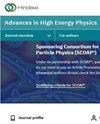利用热模型和EPOSLHC事件发生器增强LHC能量的奇异性
IF 1.1
4区 物理与天体物理
Q3 PHYSICS, PARTICLES & FIELDS
引用次数: 0
摘要
本研究对LHC能量下QGP形成的奇异性增强特征进行了仔细的研究。基于HRG,研究了在较低s~0.001到13的能量范围内,主要是奇异和多范围粒子的粒子比 TeV。奇异性增强明显出现在更高的能量下,并且比率与可用的实验数据相矛盾。使用宇宙射线蒙特卡罗(CRMC)界面模型及其两个不同的事件发生器,即EPOS 1.99和EPOSlhc,也研究了粒子比,这在整个能量范围内与模型计算结果显示出良好的一致性。我们利用它们来产生一些粒子比率。EPOS 1.99用于估计从AGS到相对论重离子对撞机(RHIC)的较低能量下的粒子比,而EPOSlhc用于LHC能量下。根据p-p碰撞的平均多重性,在4到26的能量范围内,研究了kaon和lambda粒子的产生 GeV。我们发现,HRG模型和使用的事件生成器EPOS1.99和EPOSlhc都可以很好地描述粒子比率。此外,使用这两个模型在LHC能量下估计了不同碰撞系统的冻结参数,如p-p和Pb-Pb。本文章由计算机程序翻译,如有差异,请以英文原文为准。
Strangeness Enhancement at LHC Energies Using the Thermal Model and EPOSLHC Event Generator
The strangeness enhancement signature of QGP formation at LHC energies is carefully tackled in the present study. Based on HRG, the particle ratios of mainly strange and multistrange particles are studied at energies from lower
s
~
0.001
up to 13 TeV. The strangeness enhancement clearly appeared at more high energies, and the ratios are confronted to the available experimental data. The particle ratios are also studied using the Cosmic Ray Monte Carlo (CRMC) interface model with its two different event generators, namely, EPOS 1.99 and EPOSlhc, which show a good agreement with the model calculations at the whole range of the energy. We utilize them to produce some particles ratios. EPOS 1.99 is used to estimate particle ratios at lower energies from AGS up to the Relativistic Heavy Ion Collider (RHIC) while EPOSlhc is used at LHC energies. The production of kaons and lambda particles is studied in terms of the mean multiplicity in p-p collisions at energies ranging from 4 to 26 GeV. We find that both HRG model and the used event generators, EPOS 1.99 and EPOSlhc, can describe the particle ratios very well. Additionally, the freeze-out parameters are estimated for different collision systems, such as p-p and Pb-Pb, at LHC energies using both models.
求助全文
通过发布文献求助,成功后即可免费获取论文全文。
去求助
来源期刊

Advances in High Energy Physics
PHYSICS, PARTICLES & FIELDS-
CiteScore
3.40
自引率
5.90%
发文量
55
审稿时长
6-12 weeks
期刊介绍:
Advances in High Energy Physics publishes the results of theoretical and experimental research on the nature of, and interaction between, energy and matter. Considering both original research and focussed review articles, the journal welcomes submissions from small research groups and large consortia alike.
 求助内容:
求助内容: 应助结果提醒方式:
应助结果提醒方式:


